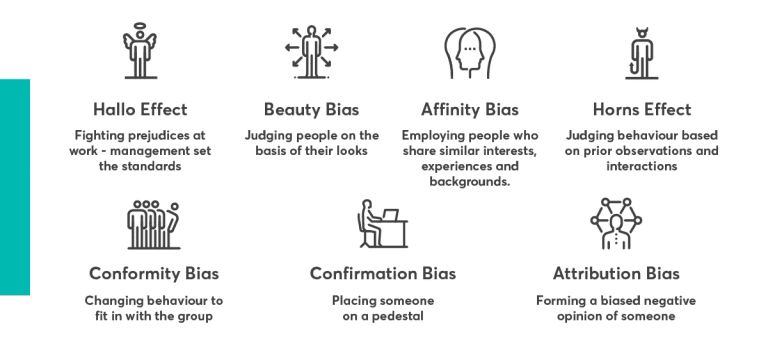Diversity management is a strategic element of all modern-day organizations. Diverse teams correlate with better-functioning businesses, happier employees, and higher revenues. Nevertheless, minorities and members of under-represented communities continue to face discrimination from potential employers. So how do we deal with prejudice at work and during the recruitment process?
The tendency to assign additional characteristics, or to categorize people, is sadly a part of who we are as a society and how we function in a group. We often favour some and discriminate against others – and this can also find its reflection in the recruitment process. Therefore, when making decisions about selecting a candidate, informed managers should recruit and promote talents in a way that minimizes the risk of being guided or informed by stereotypes and prejudices. So how should we manage diversity in our organization in order to select the best specialists from a more diverse pool of talent?
What are unconscious prejudices?
Many managers believe that intuition helps them when it comes to choosing the right candidate, but often these same first impressions are based on their own inherent prejudices. This is a tendency that most often occurs unconsciously.
When looking for a new team member, employers often make a list of the qualities they are looking for in potential candidates. Of course, there is nothing wrong with this approach, but it does come with its inherent risks. Instead, it is worth considering how to recruit with the idea of creating a diverse work environment and increasing the number of talents belonging to different groups.
“Breaking down prejudices about candidates represents a key role in the recruitment process. Therefore, the introduction of institutional, intra-organizational solutions for the development of the policy of equal treatment should always be a priority. At Devire, we believe that diversity is our strength, and equal treatment in employment is the lynch-pin principle of our turquoise management model,” says Alicja Klitenik, Diversity & Inclusion Leader at Devire.
Bias or prejudice can be manifested by candidates placing their photos on their CVs. The same candidates may also find themselves disadvantaged because of their first and last names, their home town or university, or even the narrowness of their specialization. All of these elements may seem prejudicial; but does this mean that we simply accept them as being part of the landscape? No is the answer; but it should also be emphasized that it is the employer who needs to break the stereotype and hone the potentiality of diversity in the workplace. And all the more so given that such an approach is necessary for the optimal development of the company.

Combating prejudice at work
Combating prejudice at work would not be possible without a diverse leadership team. Sustainable success can only be achieved when managers are truly committed to integration in terms of every aspect of the company’s culture. Therefore, all activities of the managerial staff aimed at promoting the idea of equality will create a peer template for the functioning of the organization; and will engage colleagues in the achieving of set goals.
The process of building an inclusive organization happens on many levels. Starting with the basics of management, we may envision the creation and verifying of strategies, not to mention policies and procedures. And from there we must give consideration to the implementation of new programs and projects which serve to deliver Diversity and Inclusion goals, both inside and outside the organization. And finally, we must constantly measure the results of activities, which means making sure that everyone in the organization has equal opportunities when it comes to recruitment, training and promotion. All these elements are necessary, but they still fall short of what needs to be achieved. The key to building an inclusive workplace starts with the management team. We are all different; and what is more, we all harbour prejudices; and tend to engage in stereotyping. But we must constantly look to address these issues; and trainings are always a great option. At the same time, we have to measure and check on an ongoing basis whether all implemented actions are bringing about the expected results – so emphasizes Marzena Strzelczak, President and General Director of the Responsible Business Forum, which coordinates the Diversity Charter in Poland.
Actions that do away with prejudices and stereotypes should be included in the employment and management policy of a given organization and followed during all key processes. Therefore offering positions and balancing the structure based on this assumption represents a vision of success. Moreover, the willingness to share good practices is one of the reasons why companies and organizations join the Diversity Charter.
Best practice
Fighting prejudice at work fosters a culture in which team members feel respected, appreciated and confident in their contribution to the development of the organization. Therefore, the challenge is to focus on the development and education of employees. The most frequently mentioned activities that create a tolerant work environment are training and mentoring. Training sessions ensure the acquisition of new knowledge coupled with the joint development of solutions aimed at promoting diversity and team integration. In turn, mentoring will help new employees to implement and better align with the culture of the organization. Only thanks to a joint effort and an innovative approach to company management will we able to create a workplace which celebrates tolerance, one where everyone feels safe and appreciated.

 Devire in Poland
Devire in Poland Devire in Germany
Devire in Germany Devire in Czech Republic
Devire in Czech Republic Devire in Portugal
Devire in Portugal
